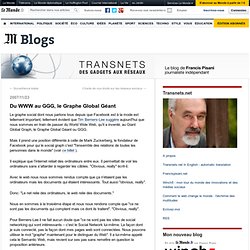

Graph Gear Demo - Example1. Giant Global Graph. Well, it has been a long time since my last post here.

So many topics, so little time. Some talks, a couple of Design Issues articles, but no blog posts. To dissipate the worry of expectation of quality, I resolve to lower the bar. More about what I had for breakfast. So The Graph word has been creeping in. Maybe it is because Net and Web have been used. The Net we normally use as short for Internet, which is the International Information Infrastructure. Simpler, more powerful. Programmers could write at a more abstract level. The word Web we normally use as short for World Wide Web.
Also, it allowed unexpected re-use. So the Net and the Web may both be shaped as something mathematicians call a Graph, but they are at different levels. Now, people are making another mental move. Biologists are interested in proteins, drugs, genes. We can use the word Graph, now, to distinguish from Web. I called this graph the Semantic Web, but maybe it should have been Giant Global Graph! Transnets » Blog Archive » Du WWW au GGG, le Graphe Global Géant. Le graphe social dont nous parlons tous depuis que Facebook est à la mode est tellement important, tellement évident que Tim Berners-Lee suggère aujourd'hui que nous sommes en train de passer du World Wide Web, qu'il a inventé, au Giant Global Graph, le Graphe Global Géant ou GGG.

Mais il prend une position différente à celle de Mark Zuckerberg, le fondateur de Facebook pour qui le social graph c'est "l'ensemble des relations de toutes les personnes dans le monde" (voir ce billet ). Il explique que l'internet reliait des ordinateurs entre eux. Il permettait de voir les ordinateurs sans s'attarder à regarder les câbles.
"Obvious, really" écrit-il. Avec le web nous nous sommes rendus compte que ça n'étaient pas les ordinateurs mais les documents qui étaient intéressants. Donc: "Le net relie des ordinateurs, le web relie des documents. " Nous en sommes à la troisième étape et nous nous rendons compte que "ce ne sont pas les documents qui comptent mais ce dont ils traitent". Lisez-le. Using labels to give semantics to tags - Design Issues. Up to Design Issues Abstract Existing user interfaces for managing, for example, mail, photos, contacts and songs allow searching using both user-generated 'tags' and also well-defined properties such as the date-time of a photograph, or the values of headers in an email message.

Users have on many web sites provided many tags, but their re-use by others has been limited due to the fact that the same tag word has quite different meaning when used by another person or used on another site. Other data, such 'geotagging' of places, declaration of friends and colleagues, by contrast, have a well-defined meaning and allow query across data from many sites. This article discusses how the user interface metaphor of a luggage label cam used to associate metadata from well-defined ontology with tags from a particular context. The article discuses ways of encoding the labels in RDF. Introduction.